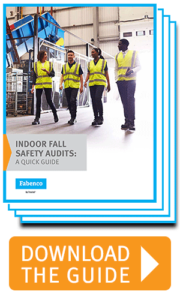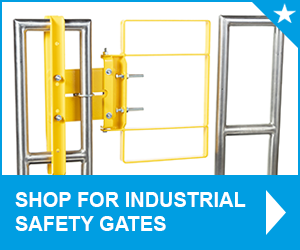
Almost 50 years ago, OSHA was enacted in an effort to eliminate workplace injury, illness, and death risks. Since then, safe work practices have risen noticeably. Workers are now trained to follow safety policies according to OSHA’s regulations. But OSHA isn’t just about training employees to recognize and reduce safety hazards. It’s also about providing safe equipment – such as OSHA compliant safety gates – and tools to all employees in every industry.
![Dowload the Indoor Fall Safety Audit Guide]() OSHA Fall Protection Compliance
OSHA Fall Protection Compliance
Serious injuries or even death can occur if a worker falls from a high place. Mezzanines, raised loading docks, holes in floors, and other situations can lead to increased fall risks. In fact, it’s one of the most common causes of serious work-related injuries. Falls are a major risk in warehouses, construction sites, and more.
It’s the employer’s responsibility to provide a safe workplace that reduces or eliminates the risk of falling. OSHA requires employers to provide safety and protective equipment free of charge to its workers.
Depending on the industry, an employer must provide OSHA fall protection if the elevation is higher than 4 feet. And if there is dangerous equipment and machinery involved, machine guarding and/or fall protection is required regardless of the elevation.
Fall protection equipment includes the following: floor hole covers, guardrails and railings, safety gates, toe-boards, stair railings, hand rails, and sometimes safety harness and line or safety nets.
OSHA Compliant Safety Gates
While the other types of equipment are important, we’re here to talk about safety gates. OSHA safety gates are necessary in a number of situations: where pedestrian traffic needs to be managed, where access control and security is needed, and where OSHA compliant safety gates are required.
Many industrial and commercial workplaces have raised work areas such as mezzanines, platforms, catwalks, and other areas where a person could potentially fall and become injured. Guardrails and gates are one of the first lines of defense. OSHA compliant safety gates, where required, are used to prevent workers from falling down stairs or through ladder openings.
You can’t just purchase or construct any guardrail or gate – it has to follow OSHA’s specific guidelines for height, strength, installation, materials, etc. Details can be found in the guidelines at www.osha.gov.
About Fabenco
In 1972, just two years after OSHA was enacted, Fabenco created its first safety gate. Fabenco safety gates all meet or exceed OSHA standards for safety. We’ve sold over 600,000 self-closing industrial safety gates over the last few decades, and we continue to offer new options to fit your facility. We can even make a custom gate for a hard-to-fit area. Our gates are easy to install and they ship straight from our facilities to your door. Give us a call today or order online if you’re in the market for an OSHA compliant safety gate.











